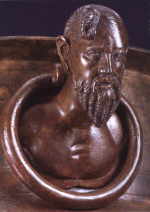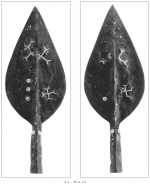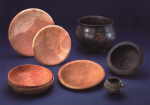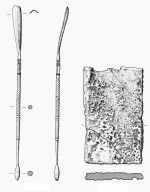 The
grave has been discovered by chance during earthmoving works during the construction
of a new road to Pasohlávky in autumn 1988. Later on its research has been undertaken
by the Regional Museum in Mikulov under the guidance of J. Peška. Originally
the grave was probably located on a small, gentle rise on the left bank of the
Thaya River, which has been made lower by gravel mining later on. The burial
site itself is located about 1.5 km to the south-southwest from the Roman military
fortification at the position of Hradisko (fig. 1). Despite a considerable dislocation
the research has succeeded in unearthing of a part of a large sepulchral chamber
in the shape of a rectangle with rounded corners and slightly narrowing walls
oriented in the northwest-southeast direction (ca 6 x 4 m). According to a great
number of both bigger and smaller stones including limestone from the near Pavlovské
Hills, some of them weighing 50 to 70 kg, inside of the sepulchral pit it may
be assumed that the burial chamber has been covered up with a wooden and stone
constructure. Marks of distortions on some of the bronze vessels caused probably
by the falling stones suggest that the sepulchre was originally hollow.
The
grave has been discovered by chance during earthmoving works during the construction
of a new road to Pasohlávky in autumn 1988. Later on its research has been undertaken
by the Regional Museum in Mikulov under the guidance of J. Peška. Originally
the grave was probably located on a small, gentle rise on the left bank of the
Thaya River, which has been made lower by gravel mining later on. The burial
site itself is located about 1.5 km to the south-southwest from the Roman military
fortification at the position of Hradisko (fig. 1). Despite a considerable dislocation
the research has succeeded in unearthing of a part of a large sepulchral chamber
in the shape of a rectangle with rounded corners and slightly narrowing walls
oriented in the northwest-southeast direction (ca 6 x 4 m). According to a great
number of both bigger and smaller stones including limestone from the near Pavlovské
Hills, some of them weighing 50 to 70 kg, inside of the sepulchral pit it may
be assumed that the burial chamber has been covered up with a wooden and stone
constructure. Marks of distortions on some of the bronze vessels caused probably
by the falling stones suggest that the sepulchre was originally hollow.
 While
the big bronze vessels lying at the sides of the grave pit were quite well preserved
(fig. 2), an approximately squared secondary intervention outlined in the middle
was related to robbery in the grave. A number of greatly damaged iron, bronze
and glass objects have been found in almost all of the layers of this intervention.
The number of the individual finds successfully retrieved from this largely
damaged burial chamber has exceeded almost 180 pieces. It was ascertained that
apart from numerous artifacts its filling has contained remains of a greater
number of sacrificial animals, e.g. a one month's piglet, a goose, a hen, also
bones of a sheep, a goat etc. A part of a quartered, about 1.5 to 2 years old
calf was found at the south-eastern wall, close to a bronze suspended cauldron.
Anthropological analyses provide evidence that probably three persons have been
buried in this grave, one of them a female.
While
the big bronze vessels lying at the sides of the grave pit were quite well preserved
(fig. 2), an approximately squared secondary intervention outlined in the middle
was related to robbery in the grave. A number of greatly damaged iron, bronze
and glass objects have been found in almost all of the layers of this intervention.
The number of the individual finds successfully retrieved from this largely
damaged burial chamber has exceeded almost 180 pieces. It was ascertained that
apart from numerous artifacts its filling has contained remains of a greater
number of sacrificial animals, e.g. a one month's piglet, a goose, a hen, also
bones of a sheep, a goat etc. A part of a quartered, about 1.5 to 2 years old
calf was found at the south-eastern wall, close to a bronze suspended cauldron.
Anthropological analyses provide evidence that probably three persons have been
buried in this grave, one of them a female.

 From
the chronological point of view is not without significance that the collection
includes some antiquated pieces which could have been passed on in a princely
Germanic family for a rather long time. It contains not only luxurious silver
vessels (fig. 3) some of them Augustan dating, but also early bronze and other
products such as a four legged table (fig. 4-5), a great decorative lamp (fig.
6), archaistic fittings and handle of a bucket of type E 24 (fig. 7-8), and
particularly an iron firedog of a late Celtic manner hitherto not encountered
in the Germanic princely graves from the 1st and 2nd centuries (fig. 9).
From
the chronological point of view is not without significance that the collection
includes some antiquated pieces which could have been passed on in a princely
Germanic family for a rather long time. It contains not only luxurious silver
vessels (fig. 3) some of them Augustan dating, but also early bronze and other
products such as a four legged table (fig. 4-5), a great decorative lamp (fig.
6), archaistic fittings and handle of a bucket of type E 24 (fig. 7-8), and
particularly an iron firedog of a late Celtic manner hitherto not encountered
in the Germanic princely graves from the 1st and 2nd centuries (fig. 9).
These are mostly artifacts that may be dated from at least the
late Republican and Augustan Periods to the years of Tiberius' and Nero's
rule. Although found in a much younger grave complex, they point probably
to the existence - sometime in the 1st century - of a Roman luxurious goods
consumers circle, perhaps members of the local Germanic nobility. They indicate
in thos way that a sort of a barbarian power centre could have been emerging
here at this early period. These facts lead naturally to another insistent
question of so far indefinable possible connection between this hoard and
the local Germanic elites about the mid 1st century. With utmost probability
such pieces could have been brought here only direct from Italy as gifts to
Germanic rulers or as a loot at the latest likely at the time of Vespasian
civil wars after the mid of the 1st century in which, as generally known,
German auxiliary troops with their kings Italicus and Sido from the area north
to the middle Danube were engaged.
 Apart
from other objects about the age of which nothing can be said for certain
the greater part of the grave equipment inventory is of a younger dating,
falling into as late as the 2nd century, possibly even its latter part. This
also holds good for the majority of bronze vessels, especially for two cauldrons
(fig. 10). The first, a noticeably bulky piece with a rounded bottom part
and two circular handles, is a rather advanced variant of the older forms
of Eggers type 6 or 8. According to some parallels from the provincial territory
this is a shape that may be reckoned with most likely from as late as mid
2nd century. The same may be said about the other bronze cauldron with a deflected
neck and a more depressed, slightly cornered bulge. As for its shape it falls
within early cauldrons of Westland type which appear in the provinces during
the latter half of the 2nd and in the 3rd century (fig. 11).
Apart
from other objects about the age of which nothing can be said for certain
the greater part of the grave equipment inventory is of a younger dating,
falling into as late as the 2nd century, possibly even its latter part. This
also holds good for the majority of bronze vessels, especially for two cauldrons
(fig. 10). The first, a noticeably bulky piece with a rounded bottom part
and two circular handles, is a rather advanced variant of the older forms
of Eggers type 6 or 8. According to some parallels from the provincial territory
this is a shape that may be reckoned with most likely from as late as mid
2nd century. The same may be said about the other bronze cauldron with a deflected
neck and a more depressed, slightly cornered bulge. As for its shape it falls
within early cauldrons of Westland type which appear in the provinces during
the latter half of the 2nd and in the 3rd century (fig. 11). 
 However
there were four bronze circular handles fastened to its sides, connected with
the vessel by means of rests or attachments carried out in the form of realistic
busts of bearded Germans wearing Suebian buns (fig. 12). The attachments were
affixed in a very careless manner, and have fallen off the sides of the cauldron
in the grave. Therefore the utensils were not intended for a daily use; they
were rather a symbolic burial gift, while the attachments were made to order
directly for the Germanic ruler. But the cauldron bulb itself could have been
manufactured independently with the rests attached to it at a later date.
A large bronze bowl with omega-shaped handles and rhombic attachments, a bottom
of a bronze bucket, probably Eggers 28 type, and presumably also two low bronze
pots with stretched horizontal edge, a narrowed lower part and a tin-coating
of the inside also fall within the 2nd century.
However
there were four bronze circular handles fastened to its sides, connected with
the vessel by means of rests or attachments carried out in the form of realistic
busts of bearded Germans wearing Suebian buns (fig. 12). The attachments were
affixed in a very careless manner, and have fallen off the sides of the cauldron
in the grave. Therefore the utensils were not intended for a daily use; they
were rather a symbolic burial gift, while the attachments were made to order
directly for the Germanic ruler. But the cauldron bulb itself could have been
manufactured independently with the rests attached to it at a later date.
A large bronze bowl with omega-shaped handles and rhombic attachments, a bottom
of a bronze bucket, probably Eggers 28 type, and presumably also two low bronze
pots with stretched horizontal edge, a narrowed lower part and a tin-coating
of the inside also fall within the 2nd century.

 The
weapons and military equipment which could be seen as insignia of the most
prominent war-chief of the tribe consist, however, only of a numerous set
of arrow - and spear-heads and lances, one of them inlaid with silver (fig.
13) and a fragment of a short one-cutting sword. A collection of 16 spurs,
some of them gold plated or with silver and gold inlays, corresponds with
the types which were common in numerous Germanic warrior-graves, dated almost
exclusively to the late 2nd century (fig. 14). The exceptional style components
of the burial equipment also include numerous belt fittings: the most spectacular
of these consisted of buckles, strap ends and a series of other ornaments
produced from gilded silver and adorned with filigree and graining (fig. 15-17).
They represent the same style of decoration as one of the pairs of spurs;
they were parts of one set (fig. 18). This type of belt fittings and spurs
apparently became a symbol of prestige confirming the special status of their
owner. While together with German shields with silver and gold plated fittings
(fig. 19) represented a typical equipment of the warrior, two golden capsule
pendants (fig. 17 on the right) produce evidence that one female person must
have been buried in the tombe probably at the same time.
The
weapons and military equipment which could be seen as insignia of the most
prominent war-chief of the tribe consist, however, only of a numerous set
of arrow - and spear-heads and lances, one of them inlaid with silver (fig.
13) and a fragment of a short one-cutting sword. A collection of 16 spurs,
some of them gold plated or with silver and gold inlays, corresponds with
the types which were common in numerous Germanic warrior-graves, dated almost
exclusively to the late 2nd century (fig. 14). The exceptional style components
of the burial equipment also include numerous belt fittings: the most spectacular
of these consisted of buckles, strap ends and a series of other ornaments
produced from gilded silver and adorned with filigree and graining (fig. 15-17).
They represent the same style of decoration as one of the pairs of spurs;
they were parts of one set (fig. 18). This type of belt fittings and spurs
apparently became a symbol of prestige confirming the special status of their
owner. While together with German shields with silver and gold plated fittings
(fig. 19) represented a typical equipment of the warrior, two golden capsule
pendants (fig. 17 on the right) produce evidence that one female person must
have been buried in the tombe probably at the same time.
 The
connection with the Roman military milieu is evoked by the tear drop strap
end, a typical equipment of Antonine dating, fragments of iron scale armour
and probably quadrelup vaned, socketed arrow-head.
The
connection with the Roman military milieu is evoked by the tear drop strap
end, a typical equipment of Antonine dating, fragments of iron scale armour
and probably quadrelup vaned, socketed arrow-head.
A majority of other small objects are also worthy of a late chronological
classification and in contrast to the earlier propositions produce evidence,
that the definitive date of the committal and the time of deposition of the
entire find collection must have been the late 2nd century. It is worth noting
that the Germanic pottery occurring in the grave manifests numerous analogies
in the local settlement structures which are datable to the same period (fig.
20 in the backround).


![]() An
important component of the grave furniture consists of the finds which correspond
with the equipment of provincial graves, falling chronologically into the
first or second century. So-called surgical instruments (spatula probe) with
a sandstone tablet (fig. 21) and thick gold plated fittings of a table or
cabinet with relief images of Roman deities may be dated back roughly to the
half of the 2nd century (fig. 22). Numerous examples of glassware are also
unusual (fig. 23): outstanding among these are the fragments of set of eight
quadrangular bottles with handles and two glass pans - trullae. Fragments
of painted glass are not missing either; samples of a Roman provincial pottery
are relatively well represented, mostly by types which were not very usual
in the German milieu (fig. 20).
An
important component of the grave furniture consists of the finds which correspond
with the equipment of provincial graves, falling chronologically into the
first or second century. So-called surgical instruments (spatula probe) with
a sandstone tablet (fig. 21) and thick gold plated fittings of a table or
cabinet with relief images of Roman deities may be dated back roughly to the
half of the 2nd century (fig. 22). Numerous examples of glassware are also
unusual (fig. 23): outstanding among these are the fragments of set of eight
quadrangular bottles with handles and two glass pans - trullae. Fragments
of painted glass are not missing either; samples of a Roman provincial pottery
are relatively well represented, mostly by types which were not very usual
in the German milieu (fig. 20).
The above statements has brought a re-appraisal of the Roman-Germanic
interrelation during the military affairs of the latter half of the 2nd century,
called Marcomannie wars. The burial furniture contains a unique body of material
illuminating the lifestyle and status of a Germanic chieftain under the Roman
control. Besides the exceptional collection of silver and bronze vessels,
a series of extraordinary burial goods, e.g. a bronze lamp, a bronze offering
table, a set of spatula probe, a number of Roman pottery and glass vessels
and other pieces, which are characteristic of Roman burial customs in the
provinces, produce evidence to the transfer of Roman belief in life after
death. The splendid silver and bronze vessels, as well as examples of Roman
furniture, might have originated as gifts from the Roman authorities to a
Germanic ally. It seems very likely that through such a personage, probably
a local king, a head of the pro-Roman party, who was probably appointed to
this dignity by the Romans at the time of the Marcomannic wars, some kind
of Roman political influence has been exerted in order to establish convenient
conditions for the further firming of Roman rule over the occupied territory.